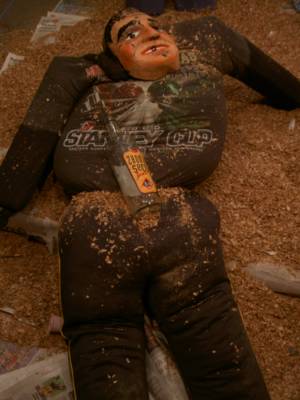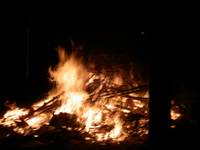Diane: Since neither the high school nor our Spanish classes have been in session this week, I decided that we should hit the countryside for a few days. Unfortunately, Sunday night I stepped on my glasses, breaking them cleanly in two. Nobody else minded that we had to wait in Cuenca a couple of extra days for a replacement. Then I caught a bad cold, which left me with insufficient energy to go get myself a meal, nevermind undertake mountain hikes. Again, nobody seemed to mind that we spent more time in Cuenca. The stench of couch-potato-itis is starting to fill every corner of the apartment.
Today we were invited to participate in the "Año Viejo" festivities with the day-care kids co-located at the school where TM and Calliope study Spanish. This is actually a day early, since New Year's Eve isn't until tomorrow. I was just too drained, so I dragged myself back to bed. Tom didn't want to go, so that left just TM and Calliope to join in the fun.
"Año Viejo" literally translates to "Old Year". But, in Ecuador it refers to lifesize figures representing someone loved or hated, someone famous or a family member, perhaps a community figure, perhaps a teacher. At midnight on New Year's Eve (or before) these figures are burned in the streets. These effigies can be political figures, especially if they have behaved outrageously in the past year. In the case of the daycare kids, they chose their teacher, Fausto, because they liked him. No matter whether the choice is out of fondness or disdain, there is the hope that burning the effigy will have a positive impact for the target during the upcoming year. Many times, people put wishes or thoughts written on small pieces of paper inside the Año Viejo.
For those that don't create their own figure, they have the opportunity to buy one. During the past week, small stands of lifesized figures have sprouted on the streets.


Tom and Calliope posed with one of the more despondent ones.
Most of those for sale are made from old clothes stuffed with sawdust, but some are made from papier mache.

There are also lots of masks. People use masks that look most similar to the person being burned. Consequently, there are many facial features available.

Burning the Año Viejo is an opportunity for theatrics, costumes, and play. Someone dresses as the widow of the Año Viejo - generally a man. These widows stop people in the streets. They beg for money to feed their children, who will be without a father once the effigy is burned. The children wear masks and the widow is generally in a black dress with a mask as well.
Well, none of the day-care kids wanted to be the widow, so Calliope volunteered. The dress they provided fit her perfectly (how did they know?). She wore the mask on top of her head and bent over as if she were a hunchback. Some of the kids guided her, since she couldn't see with her face toward the ground. She had no idea how the widow was supposed to act, and of coure she had to do everything in Spanish. Some of the kids told her what to say. As I understand it, there was a lot of laughter going around, until Calliope got her part right. Eventually, they all went around the block - Calliope the "widow" with her "husband" and all of her "children". (I still don't have any pictures, but I have been promised some)
They stopped in restaurants and stores that were known to the school staff, collecting a grand total of $4.50, which was used to buy soda and snacks. Back at the school, they all enjoyed the fruits of their labor (junk food). They burned Fausto. And then they danced.
Calliope couldn't have been more excited when she got home.
Calliope: Yo estuve una viuda! (I was a widow!)
I just had the coolest afternoon ever! Yesterday I was invited by Ines (the sister of my Spanish teacher, Patricia, and also the administrator of the school) to come and help the kids in the after school program make their año viejo.
Yesterday, the kids in the after school program decided they wanted to burn Fausto, their teacher. I went yesterday to help them build this effigy. In the end, Ines ended up making most of the effigy and the kids did almost nothing. The school is closed tomorrow, so the kids decided to burn “Fausto” today. Once most of the kids had arrived, after much playing around, we got to work. We set up “Fausto” on a bench with a painted cardboard house that the kids were going to burn him on. We set him up and put his mask, which resembled Fausto very much, over his stuffed face. Ines then came out and asked several people if they wanted to be Fausto’s “widow”.
Like my mom said, every año viejo has a widow to mourn their death by fire. Many men enjoy dressing up as the widow for this custom. The widow dresses in black and then goes around asking people for money. They usually go up to people in cars. Children stand in front of the car until they give money
As soon as the first two people declined the offer of being the widow, I immediately jumped up and volunteered. Ines gave me a mask and we went inside and I put the dress on over my clothes. The dress would have been rather skimpy, if I weren’t wearing any clothes under it. The long black dress worked perfectly with the long black scarf, which I draped over a bit of the mask and around my neck. The old woman mask reminded me of a witch, very old and by no means beautiful. TM then gave me the idea of putting the mask up on top of my head and wrapping the scarf so you couldn’t see my face. This way, I could bend over and look like a hunchback old woman. The only downside of this was that the scarf obscured my vision. All 12 kids came along with me, so they held my hands and guided me so that I wouldn’t walk into things or people.
We went into many stores and, as I was told to do, I cried and wailed about my husband, who was going to be burned this very day and asked for money. I did all this in Spanish, which was quite a challenge. At first, people gave a penny or two. Then I started getting $.50 pieces! In one store, somebody said “Oh look, I know who it is. Your hands, your hands. You have Gaby’s hands”. This confused me very much, until I realized they probably knew some other light-skinned person named Gaby. I didn’t quite know how to respond to this, but then Ines said, “No, that’s Calliope. She’s from the U.S.” The people seemed to accept that and finally put some money in the little basket I was carrying.
Some people either said that they didn’t have any money on them or asked me to wait until tomorrow. To this one of the kids, wearing a devil’s mask, growled at them. At one point or another, when people gave very curt responses saying that they would not give me money, I cried out in my teary voice, “What a bad person!” It sounds better in Spanish.
At one point, we walked into two clowns on the street. One of them cried out and tried to hide from me, saying “Aaaah!!! It’s a widow!” I cried and cried asking for money and at one point, I pretended to wipe my nose on the sleeve of one of the clowns, making a loud nose-blowing noise.
We passed by a restaurant specializing humitas (similar to tamales) and walked in. I asked for money and quite a few of the people in the restaurant and came up to me and gave me money. I tried to leave two times, but the children told me “No, wait, more people want to give you money” as more costumers came up to give me some change.
As we got closer to the school, I walked up to a woman and asked her for money. Midway through my crying speech, I realized that it was Patricia, my Spanish teacher :). She laughed and laughed and laughed and then joined the gang.
We walked around the block and in the end our total haul was $4.50 !! Money here goes a lot farther. We decided to use the money to go and buy two 2-litre bottles of coke, 3 containers of cookies, and a large bag of potato chips. We gave the remaining money to Ines.
We ate our snacks. Afterwards, each of us got a piece of paper to write down a wish for a change in the new year. I wished that my family would be happy and would learn Spanish easily. They then took “Fausto” and his cardboard house and put him on the dead-end cobblestone street in front of the school. We then put our wishes for the New Year around “Fausto” and lit sparklers. “Fausto” burned very well. After all, he was stuffed with newspapers.
They were playing music as he burned and I started to dance. Everybody laughed and wanted me to dance more. After a while, the burn got to be a little bit boring and we went to play in the playground in front of the school. It was great fun.
When “Fausto” was completely charred and black, everyone went around hugging everyone else, wishing each other a happy new year. When it was over, TM and I got a ride back to the apartment. I must say that I think this celebration is a lot cooler than our New Year’s celebrations in the U.S.
As a last note, I would like to give this question to all of you out there reading this - “If you could do an año viejo hoping the person you were going to burn would change in some way, who would you do and why?”





















































































